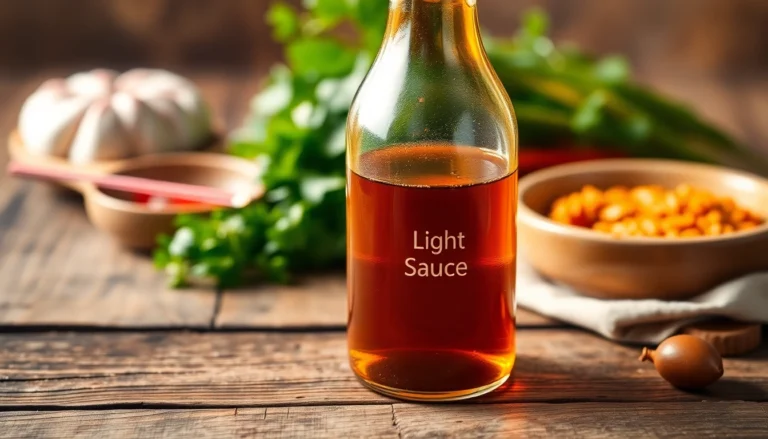Understanding Light Soy Sauce: Origins and Culinary Significance
The History and Cultural Role of Light Soy Sauce
Light soy sauce has been a staple in Asian culinary traditions for centuries, originating from ancient China where soy sauce production dates back over 2,000 years. Traditionally, it was used as a seasoning and condiment, enhancing flavor while preserving food. Throughout history, light soy sauce has played a pivotal role in Chinese, Japanese, Korean, and Southeast Asian cuisines, serving as a fundamental ingredient in stir-fries, marinades, and dipping sauces. Its cultural significance extends beyond the kitchen; it symbolizes authenticity and craftsmanship, often representing a meticulous process that combines traditional fermentation techniques with modern quality standards. As global cuisine becomes more intertwined, light soy sauce has transcended regional boundaries, becoming a key flavor enhancer in international dishes, and a symbol of culinary heritage.
How Light Soy Sauce Differs from Dark Soy Sauce
While both light and dark soy sauces are derived from fermented soybeans, their differences are marked by appearance, flavor, and culinary application. Light soy sauce is usually thinner, lighter in color, and saltier, with a sharper, more delicate umami profile. It is primarily used to add saltiness and to highlight the natural flavors of ingredients without darkening the dish significantly. In contrast, dark soy sauce undergoes a longer fermentation process and often includes caramel or molasses, giving it a thicker consistency, deeper color, and a sweeter, more robust flavor. Dark soy sauce is ideal for braising and coloring dishes, whereas light soy sauce excels in seasoning and finishing dishes where a subtle, clean soy flavor is desired.
Key Ingredients That Define Light Soy Sauce’s Unique Flavor
The distinctive taste of light soy sauce is primarily shaped by its ingredients and fermentation process. The core components include soybeans, wheat, water, and salt. High-quality soybeans are fermented with wheat, enabling the development of complex umami compounds and amino acids that deliver its characteristic savory profile. The fermentation process, often spanning several months, facilitates enzymatic breakdown of proteins into flavorful peptides. Additionally, the use of natural enzymes and controlled temperature during brewing ensures the consistency and purity of the final product. Advanced manufacturing techniques, such as enzymatic extraction and filtration, help in maintaining high standards and preserving the authentic taste. These ingredients and methods together produce a light soy sauce that is pure, balanced, and versatile for various culinary applications.
Choosing the Best Light Soy Sauce for Your Kitchen
Quality Indicators and Certification Standards
When selecting a premium light soy sauce, quality indicators such as purity, consistency, and adherence to safety standards are paramount. Certified products often carry certifications like ISO, HACCP, and organic labels, reflecting stringent quality controls. Look for clear labeling that indicates natural fermentation, absence of artificial additives, and non-GMO ingredients. Reputable manufacturers, such as Spice Nest, emphasize traceability and certification to assure consumers of authentic and safe products. Additionally, sensory evaluation—such as aroma, taste, and appearance—serves as a reliable indicator of quality. A good light soy sauce should have a pleasing aroma, a clean umami flavor, and a transparent, light golden color.
Factors to Consider: Flavor Profile, Color, and Salt Content
Choosing the right light soy sauce depends on understanding several key factors. The flavor profile should complement your dishes; a balanced umami, slight sweetness, and saltiness are ideal. The color, which should be light and translucent, influences visual appeal, especially in delicate presentations. Salt content varies; high sodium levels require moderation to prevent overpowering dishes. Manufacturers provide detailed nutritional information—select products with lower sodium content if health considerations are a priority. Additionally, the aroma should be fresh and inviting, not stale or overly pungent, indicating proper fermentation and storage.
Brand Comparisons: What Sets Top Manufacturers Apart
Top brands distinguish themselves through consistency, purity, and innovative manufacturing processes. For instance, leading manufacturers employ advanced fermentation techniques, utilize high-quality raw ingredients, and adhere to international safety standards. Transparency in sourcing and production practices, along with certifications, instills consumer confidence. Spice Nest, a prominent manufacturer, emphasizes authentic, natural brewing processes and strict quality controls to produce superior light soy sauce. Their products are certified and showcased at major food exhibitions worldwide, reflecting their commitment to excellence. Comparing brands involves evaluating taste tests, ingredient lists, certifications, and customer reviews to identify the best match for your culinary needs.
Cooking with Light Soy Sauce: Tips, Recipes, and Innovations
Popular Asian Dishes that Highlight Light Soy Sauce
Light soy sauce is indispensable in many Asian recipes, lending a subtle depth of flavor without overpowering other ingredients. Classic dishes include Chinese stir-fries, Japanese tempura dipping sauces, Korean bulgogi marinades, and Malaysian noodle dishes. For example, in a Chinese vegetable stir-fry, a splash of light soy enhances the freshness of vegetables while balancing seasoning. In Japanese cuisine, it serves as a key component of sushi rice and dipping sauces. Its versatility allows it to be used as a marinade for meats, a seasoning for soups, or as a finishing touch on steamed vegetables, elevating the overall flavor profile.
Creative Uses Beyond Traditional Cooking
Innovative chefs and home cooks are exploring new applications for light soy sauce, expanding its culinary reach. It can be incorporated into salad dressings for umami-rich flavor, mixed into dips, and used in fusion cuisines like soy-glazed grilled vegetables or soy-infused hummus. Additionally, light soy sauce pairs unexpectedly well with modern gastronomic techniques—such as being used in soy-based foams or as a marinade for plant-based proteins. Its clean, salty profile offers a subtle umami boost in vegan and vegetarian dishes, making it a staple in plant-centric cooking. Experimenting with small quantities can inspire new flavor combinations, pushing culinary boundaries while maintaining authenticity.
Balancing Flavor: Tips for Perfectly Seasoned Meals
Achieving culinary harmony with light soy sauce involves careful balancing. Start with small amounts, tasting frequently to avoid over-salting. Combining it with other seasonings—such as garlic, ginger, sesame oil, or rice vinegar—can create complex flavor layers. For marinating meats or vegetables, a mix of light soy, honey, and citrus can tenderize and flavor simultaneously. Remember that light soy sauce enhances, rather than masks, natural ingredients; thus, complementary ingredients should be fresh and high-quality. A practical tip is to add soy sauce at later stages of cooking for brightness and clarity, especially in delicate dishes.
Health Benefits and Storage Tips for Light Soy Sauce
Nutritional Content and Dietary Considerations
Light soy sauce is a rich source of flavor-enhancing amino acids and antioxidants resulting from natural fermentation. It is generally low in fat and calories, but high in sodium—making moderation essential for individuals managing hypertension or heart health. Some brands now offer low-sodium variants, enabling healthier consumption without sacrificing flavor. Additionally, organic and non-GMO options are available, aligning with today’s consumer preference for cleaner, additive-free ingredients. Though it is gluten-containing in traditional recipes, gluten-free formulations have emerged, accommodating dietary restrictions.
Proper Storage to Maintain Freshness and Flavor
To preserve the quality of light soy sauce, store it in a cool, dark place away from direct sunlight. An airtight container prevents oxidation and contamination, maintaining its aroma and flavor over time. Once opened, refrigeration is recommended to extend shelf life, especially in humid climates. Properly stored, high-quality soy sauce can last up to two years without loss of quality. Always check for signs of spoilage—such as cloudiness, off-odor, or sediment—before use.
Safety Tips and Allergens to Watch For
While generally safe, some individuals may experience allergic reactions to soy or wheat. Always read labels carefully, especially if you have known allergies or intolerances. Cross-contamination during manufacturing can introduce gluten or other allergens, so selecting certified allergen-free options is prudent. Additionally, avoid soy sauces with artificial preservatives or flavor enhancers to minimize exposure to unwanted additives.
Future Trends and Innovations in Light Soy Sauce Production
Organic and Non-GMO Options on the Rise
The demand for organic, non-GMO, and clean-label soy sauces is growing rapidly. Consumers seek products free from artificial additives or genetically modified ingredients, prompting manufacturers to adopt organic certification processes. Organic light soy sauces produced through traditional fermentation methods appeal to health-conscious buyers seeking authenticity and purity. Brand leaders are investing in transparent sourcing, supporting sustainable agriculture, and ensuring ecological balance—elements that resonate with global markets.
Technological Advances in Manufacturing Processes
Innovation in soy sauce production includes enzymatic fermentation, which accelerates aging while maintaining natural flavors, and membrane filtration techniques that ensure purity and consistency. Automation and quality control systems improve efficiency and product uniformity. Additionally, advancements in packaging—such as UV-protected bottles—help preserve aroma and flavor. These technological shifts enable manufacturers like Spice Nest to produce high-quality light soy sauces at scale, meeting increasing global demand.
Consumer Preferences and Market Growth Outlook
Market analysis indicates a significant shift towards health-oriented, clean-label products, favoring organic, low-sodium, and non-GMO soy sauces. Rising awareness about the health implications of high sodium intake has led brands to innovate healthier options. The global Asian cuisine boom, along with a surge in gourmet and fusion cooking, continues to expand the market for authentic, quality light soy sauces. Industry projections anticipate compound annual growth rates, driven by increasing exports and retail distribution channels, positioning light soy sauce as a crucial ingredient for culinary innovation worldwide.



















